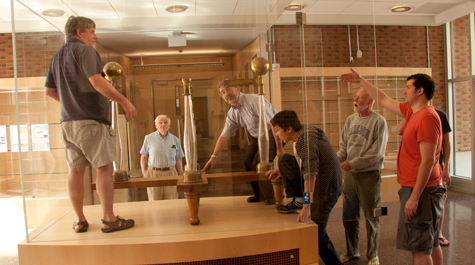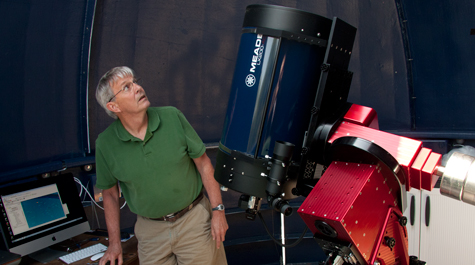Big news from Small Hall: A new telescope and a vintage generator
It’s been out with the old and in with the new for the physicists in Small Hall.
An 1859 scientific instrument came out—out of storage, that is—to reside in a new display case in the building’s lobby. The “new” is on the roof, where the department’s new telescope has been installed inside the new rooftop observatory atop the physics building. These are the finishing touches to the massive Small Hall addition and reconstruction that ended in 2011.
The expansion added 21,000 square feet for the physicists, including a newly constructed 17,320-square-foot laboratory wing. The physicists had moved into their offices and labs before the school year started, but the observatory was still unfinished.
The vintage instrument is an electrostatic charge generator; it had pride of place in the old Small Hall lobby, too. Professor Emeritus John McKnight, who has served as an unofficial historian of the physics department and its instruments, was on hand to supervise the installation of the generator. He said the generator was one of numerous scientific instruments purchased following a disastrous fire that gutted what’s now known as the Wren Building.
“I think it’s amazing that right after the Fire of 1859 they were able to collect so much money and were able to buy a bunch of equipment,” McKnight said. He notes that the generator’s provenance is well documented in archived correspondence between William & Mary President Benjamin Stoddart Ewell and William Barton Rogers, a former William & Mary faculty member who had moved to the Boston area, and who would be instrumental in the founding of Massachusetts Institute of Technology in a couple of years.
“In that correspondence, there is a description of equipment from E.S. Ritchie and Sons, a scientific supply company in Cambridge, to be sent down here,” McKnight explained. “This is one of those pieces.”
Safe storage during the Civil War
Equally interesting, McKnight says, is the strategy Ewell used to safeguard the devices during the Civil War.
“President Ewell and the faculty and all the students marched off to war,” he said. “But before that he wanted to put these expensive pieces equipment in a safe place.”
McKnight said the safest place Ewell could think of was the Eastern Lunatic Asylum, now known as Eastern State Hospital. “No army went there,” he added. Ewell’s instrument cache remained safe, even as the war raged all around Williamsburg and their former home, the Wren Building, burned once again, in 1862, at the hands of some Pennsylvania cavalrymen.
Professor of Physics Todd Averett says he has taken on the mantle of curator for the department’s vintage instrument collection. The collection includes a large number of literal museum pieces, but McKnight says the only 18th century item in the collection is an antique air pump purchased in London around 1976. Any instruments used by William Small, the professor of natural philosophy who included Thomas Jefferson among his pupils, were lost in the 1859 fire, he said.
Even without a tangible connection to the career of William Small, the vintage instrument collection is quite impressive. Smaller instruments in display cases along the lobby walls will join the electrostatic charge generator, Averett added.
Edison was 12; Tesla was 3
The generator is essentially a glass wheel suspended between a pair of large brass balls. A natural philosopher wanting to study electricity would make his own, Averett said. A crank would turn the wheel, which would pick up a static charge from a set of wool pads. The charge built up in the two conductors—the brass balls.
William & Mary scientists began using the generator to study the properties of electricity in the same year that Thomas Edison turned 12 and Nikola Tesla had his third birthday. The natural philosophers of the day even had apparatus for storing the charge they worked so hard to build up. Safely hidden out at the asylum, it survived the Civil War, as well.
“It’s a capacitor. I call it the zeppelin,” Averett says, pointing to what resembles a four-foot-long metal cigar mounted on rollers. He explained that the zeppelin was a companion instrument to the generator and made electricity portable. Scientists would wheel the zeppelin to one end of the generator and pick up the charge from one of the spherical conductors on the generator, then roll it down the corridors of the Wren Building for study of what then was usually referred to as the “electrical fluid.”
Meanwhile up on the roof of Small Hall
While other members of the physics department were moving the electrostatic field generator, Bob Vold, director of the physics department’s new observatory, was putting the new Meade 14-inch ACF reflecting telescope through its paces.
He put on a daytime demonstration for a set of visitors, which included McKnight, a former director of the observatory. Vold explained the challenges of installing the telescope and its equally important mount on the roof of Small Hall.
“The first thing you have to do when you’re installing a telescope is to make sure the mount is aligned to north,” Vold said. “That’s pretty hard to do with a compass when you have a 17.6 tesla magnet right over there.”
He was able to get a true north line on the roof the old-fashioned way, by using the stars. Once the mount was aligned and the telescope itself mounted, Vold zeroed it in, “training” the controller software that aims the telescope and rotates the dome.
“Basically you point the scope to about fifty or sixty different stars in the catalog. You center them in the eyepiece and then the software makes a model of that,” he explained. “That result is you can move the cursor on the star map on the computer, click on a star, and it is right in the field of view of the high power eyepiece without any further alignment. I’ve done that all over the sky and it really works well.”
Vold sat at a laptop and clicked on a star chart. The dome rotated until the shutter was in the proper position and the mount rotated and tiled the scope. He was able to show visitors a nice crescent Venus and a number of first-magnitude stars. The impromptu presentation was sprinkled with anecdotes of students in introductory astronomy classes who can’t believe that “the stars are out in the daytime” and details of other features of the observatory.
The observatory is fully operational now, just in time for the June 5 transit of Venus. Every hundred-odd years, Venus crosses between earth and the sun. Transits come in pairs about eight years apart, Vold said—and the 2012 event is the second of the pair. The last pair of transits occurred in 1874 and 1882, an era in which the faculty probably were still using the electrostatic field generator.
Vold notes that a cloudy evening will spoil the view of the transit. He also notes that the Small Hall observatory is not the ideal place to view the event, because the transit will start at 6:22 p.m. and even though it is less than halfway finished by sunset at 8:25 p.m. the view will be blocked after about 7:30 p.m. by a section of Small Hall .
“But I think I’m going to be up here anyway,” Vold said, gesturing around the new observatory. “I can bring my camera up here and attach it to the scope. I could get a longer viewing somewhere else, but not with this telescope.”
 Skip to main content
Skip to main content


